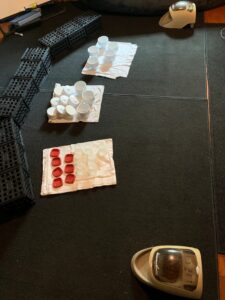
In December I blogged on Generalization and Specialization. Training dogs to recognize odor requires patience and a watchful eye from the trainer. You must be careful to reward the correct response. Too slow or too fast and you will see the pup quickly shaping behavior in a direction that may not be productive. For example, if you click or reward a beat too slow, the dog may associate the reward with looking up at you (what he was doing at the instant of the click) rather than with sniffing the odor (what you meant to reward).
This requires a lot of attention to detail. I start by cleaning all the containers so that the only difference will be if odor is present or not. “Task” started barking today during his session, forcing me to redirect his behavior to sniffing. The good news was by the end of the session I could hear deep sniffing.
Raising criteria means adding levels of complexity to the dog’s task. Going from one container (with odor) to two containers (one with odor, one without) is raising criteria because now you’ve introduced a blank container. Criteria can only be raised when the dog is proficient at a level beyond chance, meaning he gets it right the majority of the time. Each training session shapes many different criteria simultaneously: sniffing, not manipulating the containers physically (scratching, chewing, etc), adapting to different arrangements (height, depth, strength of odor, position of scent cones relative to reward machine), and distractions (both planned and unplanned). Your responsibility as trainer is to manage these criteria, adapting each repetition to the dog’s abilities so he will be challenged but still able to succeed. Don’t hurry to progress the dog, but don’t fear moving on.

